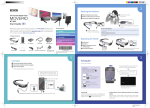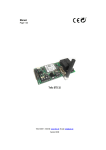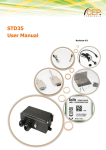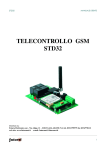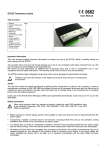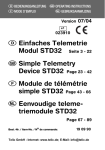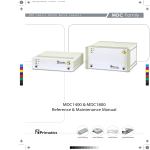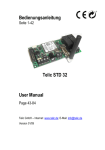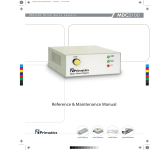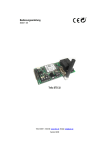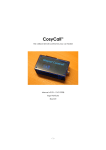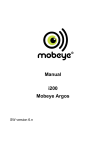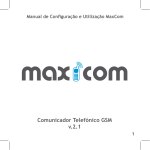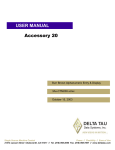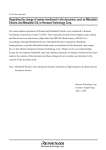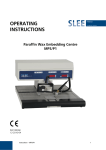Download Important information
Transcript
Table of contents Important information .....................................................23 Advice ............................................................................24 Safety Instructions .........................................................24 Operating conditions ......................................................26 Proper Use.....................................................................27 Introduction ....................................................................27 Connectors and LEDs....................................................28 Startup ...........................................................................29 Function .........................................................................33 Troubleshooting .............................................................40 Technical data................................................................41 Hotline............................................................................42 Important information This user manual contains important information for startup and use of the STD32. Read it carefully before you start working with the STD32. The warranty will be null and void should damage occur due to non-compliance with these instructions for use. We cannot accept any responsibility for consequential loss. We cannot be held responsible for material loss or personal injury that is due to incompetent use or non-compliance with the safety instructions. The warranty will be null and void in such circumstances. The STD32 contains highly integrated components which can be damaged by electrostatic discharge. 23 Therefore only touch the STD32 on the edges and avoid to touch the pins of components on the board. Advice The one who makes the module operational by adding further components or putting it into a housing, is seen as manufacturer according to DIN VDE 0869 and obliged to hand out all necessary documents with the device and to indicate his name and address. Devices which are made out of modules have to be considered as an industrial product from the safety perspective. During use of the STD32 Short Messages (SMS) can be generated automatically. Costs may occur for you by this SMS traffic. Safety Instructions • 24 When using products which are exposed to electric voltage the valid VDE-regulations have to be observed. Especially VDE 0100, VDE 0550/0551, VDE 0700, VDE 0711 and VDE 0860 are applicable. Before opening of a device always pull the mains adapter or make sure that the device is disconnected from the power supply. • • • • • • • Components, modules or devices have to be build into a housing before they are put into operation. During installation they should not be connected to any power supply . You should only use tools on components, modules or devices if they are disconnected from the power supply and the electric charge, which may still be stored in some components, inside the device has been discharged. All cables and wires which are energized and connected to the device, the module or components have to be checked regularly for any damage of the isolation shield or fractures of the cables. If the supply cables are visibly damaged the device has to be taken out of operation immediately until the faulty cable has been exchanged. When using components or modules it is necessary to strictly observe the specification given in the corresponding description of these components. If a description for a private end-customer not clearly states which electric data is valid for a component or a module, how to wire the device, which external components or additional devices can be connected or which parameters these components are allowed to have, a specialist must be contacted. Before putting a device into operation, it has to be clarified, whether this device or module is meant for the field of application. In case of doubt ask specialists or the manufacturer of the device. Please note that we are not responsible for any errors in usage or connection. Therefore we cannot accept any responsibility for consequential loss. 25 • • • Devices which operate with >35 Volt have to be connected by a specialist. Before putting the device into operation it should be checked that there is no current leakage on the housing. In case that measurements with the opened housing are necessary, an isolating-transformer has to be integrated for saftey reasons. Alternatively the voltage can be supplied by an appropriate power supply which complies with the safety regulations. All wiring work has to be done in a voltage free state only. Operating conditions • • • • • • • • 26 Operate the STD32 only with a supply voltage between 532V and have in mind the polarity! (see picture1) The power supply has to deliver at least 500mA. If you use a mains adapter for power supply it has to be conform with the VDE regulations. Devices with an operating voltage >35 Volt have to be installed by a specialist observing the VDE regulations. Loads connected to the device are not allowed to exceed 1000W per relay. The maximum voltage is 250V AC (alternating current) The maximum switching power per relay is 6A (depending on the width of the PCB tracks) No special operation position of the device has to be observed. When installing the device make sure that the supply cable has a sufficient diameter During operation the temperature has to be between -20° and 55° Celsius. • • • • • • • • In case of condensation allow a period of about 2 hours for acclimatisation. Keep away the device from flower vases, bath tubs, washbasins, liquids etc. The device is meant for operation in dry and clean rooms. Protect the device from humidity, spray water and heat. Do not expose the device to heavy vibrations. Do not operate the device in areas where are or could be inflammable gas, vapours or dust. The unit may only be repaired by a specialist. Only original parts have to be used when repairing the unit. The use of differing spare parts can cause serious material loss or personal injury. Proper Use The device is designed for the remote switching of devices via the GSM network as well as the remote retrieval of status information of the inputs and the generation of SMS messages after status has changed at the inputs. A different utilisation of the device other than the one described above is not allowed. Introduction The STD32 is a telemetry module which is easy to install and simple to use. With the STD32 you can control two relays and monitor the status of two digital inputs with one or several common mobile phones. 27 Apart from the STD32 you only need a valid SIM Card of any network provider (GSM 900 / 1800 MHz). While using prepaid SIM-cards one shall always keep himself aware of the amount left on the card, so that in case of alarms a SMS could be sent. Typical fields of application are the opening of (garage) doors, switching on and off light and alarm devices as well as generating alarm messages (SMS) or the retrieval of information from door sensors, movement sensors or level sensors etc. Connectors and LEDs IN1 Relay Relay 1 2 IN2 P W R ANT STD32 Relays Inputs L1 L2 L3 L4 Status LEDs figure 1 28 GSM engine GSM LED As described in figure 1 the STD 32 has four pairs of screw terminals. Two pairs (In1, In2) are inputs to two optocouplers. The other two pairs (Relay1, Relay2) are outputs (switches) of the 2 relays of the STD32. PWR: connect the supply voltage of the STD32 here. ANT: connect the GSM antenna here. When the engine is booked into the GSM network the GSM LED is flashing once every 2 seconds. The status LEDs show the status of the inputs and outputs. L1 and L2 are on if the corresponding relay is activated. L3 and L4 signal the status of the optocoupler inputs IN1 and IN2. Please observe the maximum output voltage of the relays and the maximum input voltage of the inputs! In the following chapter „Startup“ you will find further information on this. Startup You need an activated SIM card of a GSM network provider. The PIN of this card has to be set to „0000“. To change the PIN you can use a common mobile phone. The instructions how to change the PIN are described in the manual of your mobile phone. 29 If you use a SIM card with a PIN different from „0000“ in the STD32, the STD32 will use a „wrong“ PIN after every restart. After the third trial your SIM card will be blocked. In this case you need to use the „Super-PIN“ or „PUK“ to assign a new PIN to your card. Please look into the user guide of your mobile phone. There you find how to use the PUK to de-block the SIM card. Should you wish to use a SIM card which does not require a PIN, this is also possible and the STD32 recognizes this and will behave accordingly. Before connecting the supply voltage to the STD32 please insert the SIM card into the SIM card holder on the backside of the STD32: To open the SIM card holder move it sideward and flip it open; insert the card (mind the orientation) and close it again. To fix it move the top sideward in opposite direction. Connect the antenna, if not already done. Now connect the power supply. Shortly after that the GSM LED will shine constantly. Now the STD32 will automatically try to connect to the GSM network. As soon as this is done, the GSM LED will be flashing once every 2 seconds. 30 General STD32 basically could be configured with following two methods: 1. Configuration call (“Easy Setup”) When STD32 is supplied with power for the first time then it can be configured through a phone call within the first 3 minutes of power supply. Thereafter STD32 saves the number of the mobile phone it is being called from (only if the number is being transmitted) and in future sends the SMS of the events to this number. You can also switch one relais through a simple call from this ‘known’ number to the STD32. The STD32 can be configured through call from this number for simple activities. You don’t need to use a computer or send SMS to perform these activities. 2. Configuration through SMS (“Professional Setup”) For complex tasks, such as switching both outputs, configurating additional phone numbers which are allowed to trigger an output or receive alarm messages, changing standard text, changing input pulse time and many other complex parameters the STD32 can be very easily programmed through a simple SMS. In case you want to reset STD32 to factory settings to be e.g. able to make a new configuration call this is also possible through SMS. Please refer to “SMS commands” for configuration through SMS. 31 Configuration call Wait until the GSM LED is flashing. Now take the mobile phone with which you want to control the STD32 and call the phone number of the SIM card which is inside the STD32. The STD32 will accept the call and cancel it a few seconds later. During this call, a four digit DTMF sequence is send to the caller and you will hear them on your mobile phone. With this call the STD32 is configured to the mobile phone. Pay attention that your mobile phone is transmitting the phone number which means that the GSM functions “incognito” or “private call” are disabled. You can change this configuration by inserting the SIM card into a mobile phone. To test the setting you can call a different mobile phone; there your phone number or name should be displayed. In case the STD32 will be separated from the power supply by a power failure it will automatically send a SMS with the text „START-UP ALARM“ to the preconfigured telefone number as soon as the power supply is established again. Note: The red LEDs of the STD32 will blink cyclically as long as the STD32 is not configured by a configuration call or a SMS (factory setting). After 3 minutes the device is switching off. If you switch it on again afterwards the STD32 is again expecting the configuration. 32 Function After having configured the STD32 the following functions are available (see chapter „Startup“): Switching by phone call After having completed the configuration please call the phone number of the SIM card which is inside the STD32. Please pay attention that your phone number is transmitted by your mobile phone (see chapter Configuration call). Now the relay should switch for a certain time (Factory setting is 1 second). The status LED for relay 1 is shinging during that. Generate an alarm SMS Connect 12V (factory setting) to an input for one second and mind the polarity. An alarm SMS will be sent to your mobile phone Send SMS commands You can control outputs or configure the STD32 by sending SMS to it. Those SMS have the following format which is described below: In order to avoid unauthorized usage of the STD32 it is protected with a password. Every SMS to the STD32 must start with a 4-letter password. 33 The factory set password is the last four digits of the IMEI number of your STD32. You find YOUR IMEI number on the GSM module of your STD32. The last four digits of the IMEI being the password for your device must always be kept as a secret. The IMEI cannot be changed!!! Although the password can be changed if needed for security purposes, you should keep in mind that every command – including setting back to factory setting – requires the knowledge of the password. All commands (except R: and ST?) must end with a full stop (.)! All commands can be sent in one SMS; each command has to be separated from the next by a full stop. 34 The parameters for the seconds can have 1-5 digits. Valid parameters are e.g. 1, 90 or 99999. No leading “Zeros” have to be added. Example: “O1:90” stands for 90 seconds. Please observe the difference between the figure ‘0’ and the letter ‘O’!. (O1ON. Contains twice the letter O; V1:0. contains once the figure 0) Basic functions • • • When you call the STD32 from the configured mobile phone the relay 1 switches for one second. Immediately after that the STD32 sends a reply SMS with the actual status of the inputs and outputs. When the digital input IN1 is activated for one second, the STD32 sends a SMS with the text „EVENT ALARM1“ to the preconfigured phone number When the digital input IN2 is activated for one second, the STD32 sends a SMS with the text „EVENT ALARM2“ to the preconfigured phone number. Switching through SMS • • After the STD32 has received a SMS with the text „O1ON“ (Output 1 ON) from the configured mobile phone, the relay 1 switches for one second. With the SMS „O2ON“ relay 2 switches for one second. If the switching time has been set to 0 by a configuration SMS the relays switch permanently. 35 Configuration SMS • • • • • • • 36 A SMS with the text „O1:xxxxx“ or „O2:xxxxx“ (xxxxx = seconds) configures the switching time of the relays. The STD32 saves these settings so that they are still available after the supply voltage has been restored. If the switching time has been set to 0 by a configuration SMS the corresponding relay switches permanently at every call. If the relay has been active before it will afterwards be inactive and vice versa. In this case a SMS with the text „O1ON“ from the configured mobile phone switches the relay 1 permanently on. A SMS with „O1OFF“ permanently switches off relay 1. Relay 2 is reacting accordingly to SMS messages with „O2ON“ and „O2OFF“. With a SMS with the text „I1:xxx“ or „I2:xxx“ (xxx = seconds) you can configure the time the inputs have to be activated before the STD32 sends out an alarm SMS. A SMS with the text „V1:x“ or „V2:x“ (x = 1 or 0) can change the polarity of the inputs. If x=1 an alarm SMS will be sent in case the input has not been activated for the configured time. You can activate or deactivate the Start up SMS (STARTUP ALARM) with the SMS „S:x“ (x = 1 or 0). The SMS „R:“ is setting the STD32 back to the factory settings. To get a feedback of the actual status of the inputs and outputs just send a SMS with „ST?”. • • • • • The SMS „A1:xxx“ or „A2:xxx“ (x = seconds) sets the delay after which a reply SMS is sent after an output has been activated. This can be helpful if you want to switch something on or off and would like to measure the result of this output control with one of the inputs of the STD32. Therefore the new status after the switching of the output is transmitted. With the “PN:<4digit password>.” command the password can be changed. The password can include letters and figures but no special characters are allowed. All letters have to be in capital. The standard password (factory setting) is the last 4 digits of the IMEI (see chapter SMS Commands). Four additional alarm numbers can be defined using C2: C5: commands. These numbers are allowed to set relay 1 by a call and they are informed via SMS in case of event1,2 and start up. These numbers are not allowed to send configuration SMS. If an alarm number is given in international format, the number must start with ‘+’. You can generate an extended clip list of several 100 clip numbers. These numbers stored in the clip list are allowed to switch relay 1. Use “CL:” to generate the clip list and add further phone numbers. With “CD:” you can delete a phone number from the list. The texts of the event or start up SMS can be changed with the commands “E1:<text1>”, “E2:<text2>” and “PT:<startup text>”. The message length must not exceed 64 characters. Do not use command syntax inside a message text. The ‘.’ is the terminating character of the text. Each new text must be sent in a separate SMS. 37 Table of SMS Commands Factory settings Status of I/Os Start SMS on/off Relais 1 on Relais 1 off Relais 2 on Relais 2 off Switching time Relais 1 Switching timeRelais 2 Delay before reply (Relais 1) Delay before reply (Relais 2) Time of activation Input 1 Time of activation Input 2 Invert Input 1 Invert Input 2 2. alarm number 3. alarm number 4. alarm number 5. alarm number new password event text 1 event text 2 start up Text add clip to the extended clip list remove clip from the extended clip list 38 R: ST? S:1. / S:0. O1ON. O1OFF. O2ON. O2OFF. O1:xxxxx. (seconds) O2:xxxxx. (seconds) A1:xxx. (seconds) A2:xxx. (seconds) I1:xxx. (seconds) I2:xxx. (seconds) V1:x. (x= 1/0 ) V2:x. (x= 1/0 ) C2:<number>. C3:<number>. C4:<number>. C5:<number>. PN:xxxx. E1:<text>. E2:<text>. PT:<text>. CL:<nummer>. CD:<nummer>. Examples for SMS Commands Start up Alarm off, Relay 1 on, Relay 2 off, time of activation of input 1: 5 sec.: SMS: 2759 S:0.O1ON.O2OFF.I1:5. Switching time of relay 1 = 90 seconds: SMS: 2759 O1:90. Reset settings to factory settings: SMS: 2759 R: Configuration of the second alarm number: SMS: 2759 C2:+491721234567. Deleting a alarm number: SMS: 2759 C2:. Configuration of a new password: SMS: 2759 PN:AB12. Adding a new clip to the extended clip list: SMS: AB12 CL:491721234567. Removing the clip from the extended clip list: SMS: AB12 CD:491721234567. 39 Troubleshooting Problem GSM LED stays dark GSM LED blinks twice cyclically Possible reason No supply voltageNo SIM card / Improper contact with SIM card GSM LED blinks thrice cyclically PIN is not “0000” GSM LED constantly on No GSM network available / no antenna connected No configuration GSM LED dies after 3 minutes STD32 does not react on configuration call (not accepting the call) STD32 does not react on configuration SMS 40 Device is already configured Wrong IMEI number in the SMS / SMS not yet delivered Solution Connect power supply Insert SIM card properly or carefully clean contact area of SIM card Change SIM card’s PIN to „0000“ Connect antenna / Change antenna position Make configuration call Set back to factory settings Check IMEI number. / Wait until SMS is delivered STD32 does not react on SMS, or call, although booked to the network Both red LEDs blink consecutively The mobile phone does not transmit the phone number („Incognito“) No configuration call received by STD32 Activate the transmission of the phone number in your mobile phone Makw a configuration call Technical data • • • • • • • • • GSM: Dual Band EGSM 900/1800 MHz Compatible with ETSI GSM Phase 2+ Standard Output power: Class 4 (2W @ 900 MHz) Class 1 (1W @ 1800 MHz) Temperature range: -20°C - +55°C Weight approx. 100 gramme Dimensions: 100x53x25 mm (lxwxh) Supply voltage: 5-32V Idle current:15mA, Peak up to 500mA Max. output voltage: 6A Max. voltage: 250V AC Input voltage (digital inputs) logic 1: 12 V logic 0: 0V input current: 10mA 41 Hotline In case of technical problems or questions concerning the STD32 our hotline is available for you: Monday – Friday: Technical Hotline: 9 am – 5pm +49 (0)89 / 450292-11 For all other questions please call Sales +49 (0)89 / 450292-0 Issue: Juli 2004. Subject to change without notice! 42




















